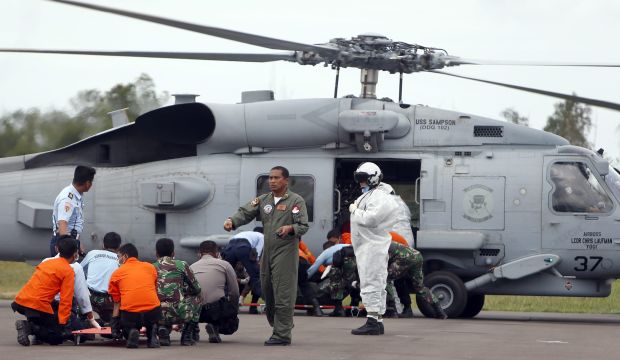
Indonesian rescuers and US Navy members unload bodies from a Seahawk helicopter at Iskandar Military Airport in Pangkalan Bun, Central Borneo, Indonesia, on January 2, 2015. (EPA/Adi Weda)
Jakarta, Bloomberg News—Search teams looking for the crashed AirAsia jetliner found bodies still strapped in their seats and debris resembling parts of the tail, as they deployed sonar and pinger locators to seek the plane’s data recorders.
The Indonesian navy picked up the bodies wearing seat belts and found the debris by sonar, said Col. Yayan Sofyan in an interview on Metro TV Friday. The tail is the location for the flight-data recorder, which together with the cockpit-voice recorder is known as the black box.
“Our team found what we suspect is a fraction of the aircraft tail,” Sofyan said. “It was at the bottom of the sea, at 29 meters deep.”
Heavy seas and wind exceeding 40 knots in the search area are delaying progress while 10-foot (3 meter) high waves are preventing divers from going down. Bad weather is expected to persist through January 4, Indonesia search and rescue agency chief F.H. Bambang Sulistyo said at a briefing Thursday night in Jakarta.
The international team set 1,575 square nautical miles as the most likely area to find the plane wreckage, Malaysia’s Navy Chief Abdul Aziz Jaafar said Friday in a Twitter post.
Divers, helicopters, planes and ships have scoured the Java Sea for the remains of Flight 8501 in a search that has so far helped recover 30 bodies. The black box of the Airbus Group jet has eluded recovery efforts near Pangkalan Bun, about 600 miles (1,000 kilometers) southeast of Singapore. Parts of the plane were identified after sonar contact at 79 feet (24 meters) under water, Hadi Tjahjanto, a spokesman for Indonesia’s air force, said earlier.
Recovering the fuselage and black box of the A320 plane that went down with 162 people on board could help answer why the six-year-old aircraft on a routine commercial flight to Singapore from Surabaya in Indonesia crashed on December 28. Flying at 32,000 feet, the pilot asked to move to a higher altitude, citing clouds, officials have said.
An “abnormal situation occurred” at that height, said AirNav Indonesia, the nation’s air-navigation operator. Air traffic control gave the plane permission to ascend to 34,000 feet after checking flights in the area and coordinating with other airports, Bambang Tjahjono, AirNav’s head, said Friday.
More than 90 vessels and aircraft have been involved in the operation that has so far found objects including what appears to be an emergency door and an evacuation slide.
The recovery effort will involve salvaging large pieces of the plane, engines, landing gear and other wreckage requiring heavy-duty lifting capability. The parts will then be pieced together for the investigation. Indonesia has sent a tanker to help, Sulistyo said.
The black boxes, which are encased in bright orange to facilitate their retrieval, are waterproof, fortified and designed to emit an electronic signal underwater for 30 days to help searchers find them.
Flight 8501 was the third high-profile incident involving a carrier in Asia last year, raising safety concerns in one of the fastest-growing aviation markets in the world. AirAsia is the biggest customer by units of the A320, a workhorse airliner that’s used by hundreds of carriers around the world.
A spate of crashes in the past decade had prompted Indonesia in 2008 to amend laws and boost plane-safety checks after the European Union imposed a ban on its carriers from flying to Europe. The ban was partially lifted later. Indonesia had 3.77 fatal accidents for every 1 million takeoffs in the three years ended March 31, London-based aviation adviser Ascend said in 2007. The global rate was 0.25 then.
